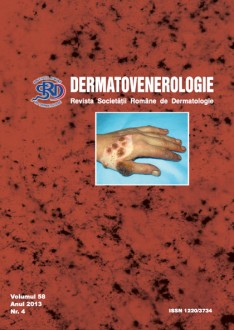Insuficienta venoasa cronica a membrelor inferioare are la baza intoarcerea venoasa inadecvata si cresterea presiunii venoase intracapilare, cauzate de tromboflebitele profunde, varicele hidrostatice sau, mai rar, de catre displazii venoase congenitale. Expresia sa clinica este reprezentata de dermatita de staza – afectiune inflamatorie cutanata cu evolutie stadiala, cuprinzând edem, dermita ocra (purpurica si pigmentara) Favre si Chaix, dermatofibroscleroza si ulcerul cronic de gamba .Dintre posibilele complicatii ale bolii, cea mai frecventa este reprezentata de eczematizarea leziunii printr-un proces iritativ, alergic sau de cauza endogena, aceasta putând fi
insotita sau nu de aparitia unei eruptii secundare la distanta, iar cea mai redutabila complicatie este tromboza venoasa profunda, care la rândul ei poate determina un tromboembolism pulmonar, cu o rata crescuta a mortalitatii. Tratamentul dermatitei de staza include o gama larga de optiuni medicale sau chirurgicale, insa este important de retinut ca, in absenta corectarii agentului etiologic – insuficienta venoasa cronica, vindecarea afectiunii nu este posibila.
In cadrul lucrarii de fata prezentam cazul unui pacient in varsta de 82 de ani, cunoscut cu afectiuni asociate din sfera cardiovasculara si reno-urinara, precum si cu dermita de staza Insotita de eczema cronica diagnosticate cu 1 an inaintea episodului actual. Pacientul a solicitat internarea in clinica noastra In urma reaparitiei a multiple placi si placarde eritemato-scuamoase pruriginoase localizate la nivelul membrelor inferioare, pe un fond de dermita ocra cu
tendinta la lichenificare, precum si numeroase leziuni cu morfologie similara distribuite la nivelul coatelor, genunchilor si coapselor bilateral, aflate In evolutie de circa 9 luni. Examenul clinic obiectiv si explorarile paraclinice au relevat prezenta unei formatiuni tumorale pulmonare, initial de origine incerta – parazitara, tromboembolica sau neoplazica.
Cuvinte cheie: dermita de staza eczematizata, insuficienta renala, tumora pulmonara, chist hidatic pulmonar, tromboembolism pulmonar.
In cadrul lucrarii de fata prezentam cazul unui pacient in varsta de 82 de ani, cunoscut cu afectiuni asociate din sfera cardiovasculara si reno-urinara, precum si cu dermita de staza Insotita de eczema cronica diagnosticate cu 1 an inaintea episodului actual. Pacientul a solicitat internarea in clinica noastra In urma reaparitiei a multiple placi si placarde eritemato-scuamoase pruriginoase localizate la nivelul membrelor inferioare, pe un fond de dermita ocra cu
tendinta la lichenificare, precum si numeroase leziuni cu morfologie similara distribuite la nivelul coatelor, genunchilor si coapselor bilateral, aflate In evolutie de circa 9 luni. Examenul clinic obiectiv si explorarile paraclinice au relevat prezenta unei formatiuni tumorale pulmonare, initial de origine incerta – parazitara, tromboembolica sau neoplazica.


